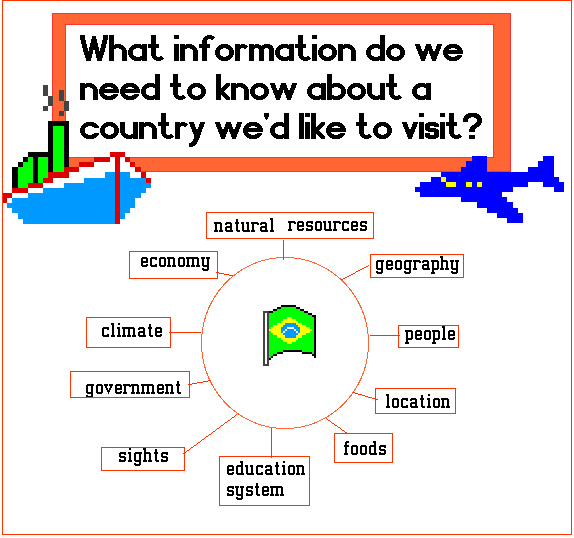|
P. S. 101 |
|
|
P. S. 101 |
|
|
|
Aims:
1. To establish the type of information that should be included in a virtual tour of Brazil.
2. To develop ideas of what would be necessary to know before traveling to a country like Brazil.
3. To develop the concept that a country is made up of its economics, geography, climate, location, culture, history, society, education, places and government and that each of these factors influences the country's place in the global setting.
Standards:
1. Focuses on economic/geographic,
social, cultural, political and historic elements of South America.
2. Develops proficiency
in using the Internet as a research tool.
3. Produces and share written and oral reports.
4. Participates in group meetings.
Setting: 5th grade class
Materials: computers with Internet capabilities, samples of travel brochures (can be gotten from travel agencies), printer
Vocabulary:
Use dictionary.com to introduce and define the following vocabulary words.
| destination | location | geography | climate | sights | history |
| economy | demography | government | occupation | natural resources | culture |
1. Ask students, "If you were going to go on a trip to Brazil, what information would be important to know about Brazil? Write responses on a semantic map.
 |
1. Show printed travel brochures which can be gotten at any travel agency to the class and have the students visit the following travel agency web sites. What information is found on these web sites and printed travel brochures?
At this site students will get a virtual tour of Brazil. Information includes a history of Brazil and sights to see.
At this site students will find photos and links to destinations in Brazil and the activities that one may participate when traveling.
2. What additional information should we include in travel brochures that we will make? (Responses may include transportation, hotels, cost of trip). Additional responses may be added to the semantic web.
http://worldtravelguide.net/navigate/world.htm#
Students click on the link to "create a mini guide" for a "country." They will then choose South America and click on the picture of Brazil on the map shown. A mini guide of Brazil will be created.
Summary:
Students in class will be placed in cooperative learning groups. (If 10 topics are to be researched by the class, 10 groups may be formed. Five groups may be formed if each group researches two topics). Each group will be responsible to obtain and share information related to one of the topics listed on the semantic web, both within the cooperative group and ultimately with the class. Roles for the cooperative groups will be discussed and given out. Roles include: researchers who will find information online using web sites chosen by the teacher, recorder who will record the important information found by the researchers (information may be recorded using a word processing application such as Learning Company's Student Writing Center or Microsoft Word), illustrators who will be responsible to find online photos (from web sites that will be prescreened by the teacher) or create illustrations of the topics researched by the group using a drawing and painting application such as Kidpix, reporters, who share the information with the class both in oral reports and in written reports, and web designers who will place the textual information, photographs, and graphics onto a web site for the class Virtual Travel Brochure.
Each student will receive a copy of all completed written reports to keep in a folder or binder for future reference.
Evaluation:
Students will be evaluated on their ability to work cooperatively,
on the comprehensiveness of the information found, and on the presentation
of the oral and written reports.